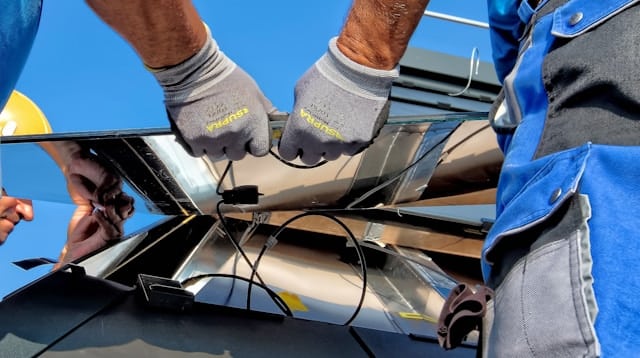What Innovations Are Enhancing the Portability and Efficiency of Solar Chargers?

Solar energy is among the most abundant and readily available renewable energy sources on our planet. With the current emphasis on sustainability and reducing our carbon footprint, solar power is taking centre stage. This, in turn, is driving significant innovations in solar technology, specifically in portable solar chargers. Now, let’s delve into how the latest advancements are making these devices more portable and efficient.
Pocket-sized Portability: Innovations in Solar Charger Designs
In the past, solar panels were large and bulky, limiting their portability. However, advancements in solar technology have led to the development of compact, foldable, and lightweight solar chargers that can easily fit into your pockets or backpack. This is a significant leap from the traditional rigid panels which were not only weighty but also had limited application due to their static nature.
Also to read : Elevate your video editing experience with PlayPlay today
One of the most exciting innovations in this regard is the introduction of thin-film solar cells. These cells are made using a process that places multiple thin layers of photovoltaic material onto a substrate. The result is a lightweight, flexible solar panel that can be integrated into a variety of products, including portable chargers.
With these advancements, you can now carry a solar charger to charge your devices anywhere, from a hiking trail to a music concert, without worrying about its weight or space. It’s not an exaggeration to say that you’ll have an off-grid power source right in your pocket!
Also to discover : Convert and download your favorite soundcloud tracks easily
High Efficiency: Maximizing Solar Energy Conversion
Along with increased portability, another significant focus in the solar charger technology development is efficiency. After all, what good is a portable charger if it takes forever to charge your devices, right?
Traditionally, solar panels have suffered from relatively low efficiency, converting only about 15% to 20% of the sunlight they capture into usable electricity. However, recent innovations are pushing these boundaries.
Companies are now developing high-efficiency solar cells that can convert a greater portion of sunlight into electricity. These include multi-junction solar cells, which are designed to capture and convert a broader range of the solar spectrum. In laboratory conditions, these cells have reached efficiencies exceeding 40%!
Another exciting development is the use of concentrator photovoltaics (CPVs). CPVs use lenses or mirrors to focus sunlight onto small, high-efficiency solar cells. This technology can significantly improve the power output of portable solar chargers, even in conditions of less-than-ideal sunlight.
Cutting the Cord: Wireless Solar Charging
Imagine a world where you can power your devices without having to worry about tangled cables or finding a plug socket. Wireless charging is the future, and solar power is playing a crucial role in this.
Wireless solar chargers utilise inductive charging technology, where power is transferred across an electromagnetic field, enabling you to power your devices without any physical connection. Such chargers are designed with built-in solar panels that capture and convert sunlight into electricity, which is then stored in an internal battery.
Among the significant benefits of wireless solar chargers is the convenience they offer. You don’t need to carry around cables or look for an outlet. Just place your device on the charger, and it starts charging. They’re also great for outdoor use, allowing you to harness the power of the sun while camping, hiking, or just enjoying a day at the beach.
Breaking Down Barriers: Decreasing Costs and Increasing Accessibility
One of the barriers to widespread adoption of solar technology has been the high cost. However, this is rapidly changing with the advancements in technology and increased market competition.
The cost of solar panels has dropped dramatically over the past decade, making solar power more affordable than ever. This trend is reflected in the market for portable solar chargers, with more affordable options becoming available.
Furthermore, advancements in storage technology are also contributing to cost reductions. Traditional batteries used in solar chargers are expensive and have a limited lifespan. However, newer technologies like lithium-ion batteries and solid-state batteries promise higher energy density, longer lifespans, and lower costs.
These advancements are not just making solar chargers more affordable, but they are also making them more accessible to a broader audience. Whether you’re an adventurer looking for a reliable off-grid power source or a city dweller looking for an eco-friendly way to charge your devices, there’s likely a solar charger that fits your needs and budget.
Embracing the Future: Integration with Smart Technology
The future of solar chargers is not just about portability and efficiency; it’s also about smart integration. With the rise of the Internet of Things, solar chargers are now being designed to integrate seamlessly with other technologies.
For instance, some solar chargers now come equipped with smart features like automatic device detection, which can identify the type of device connected and optimise the charging process for it. There are also solar chargers with built-in Bluetooth connectivity, allowing users to monitor and control the charging process via a smartphone app.
This integration with smart technology is making solar chargers more user-friendly and versatile, further driving their adoption. As the technology continues to evolve, you can expect to see solar chargers that are not just portable and efficient, but also smarter.
Sustainable Energy Solution: An Eco-friendly Alternative
With climate change looming as a significant global issue, the need for sustainable energy solutions has never been more critical. The shift from fossil fuels to renewable energy sources is a crucial step in mitigating the environmental impact. In this context, solar chargers serve as an eco-friendly alternative to traditional charging methods.
Traditional charging methods typically rely on non-renewable energy sources like fossil fuels, which contribute significantly to greenhouse gas emissions. Unlike these methods, solar chargers harness sunlight, a clean and renewable energy resource, to generate electricity. This process does not produce any harmful emissions, making solar chargers an environmentally-friendly option.
In addition to being eco-friendly, solar chargers also offer a sustainable solution for energy consumption. Rather than consuming power from the grid, which often involves burning fossil fuels, solar chargers allow you to generate your own electricity directly from sunlight. This not only reduces reliance on the grid but also contributes to energy independence.
Moreover, the use of solar energy is not limited to ideal sunny conditions. Many of today’s solar chargers are designed to collect energy even in cloudy or low-light conditions, allowing for consistent energy production. These chargers also come with energy storage systems, such as batteries, to store excess power for later use.
Through these features, solar chargers provide a sustainable and eco-friendly alternative to traditional energy sources. By embracing solar power, we can reduce our carbon footprint and contribute to a greener future.
Powering Ahead: Future Prospects of Solar Chargers
Solar energy is a rapidly advancing field, with constant innovations enhancing the portability, efficiency, and versatility of solar chargers. Yet, these are just the opening chapters in the story of solar-powered technology. As research continues and technology advances, we can expect even more exciting developments in the world of solar charging.
One of the future prospects of solar technology lies in the development of ‘smart’ solar chargers. These chargers will not only be highly portable and efficient but will also incorporate advanced features such as remote monitoring, predictive analytics, and machine learning capabilities. This will allow for more precise energy management, enhancing efficiency, and optimising energy use.
In the future, we might also see the emergence of more robust solar charging networks. Just as there are networks of petrol stations for conventional vehicles, we might see networks of solar charging stations for electric vehicles and other devices. This would greatly enhance the ease and convenience of using solar-powered devices.
Another area of future potential is the integration of solar panels with architectural design. Solar chargers could be incorporated into the design of buildings, public spaces, and transportation systems, providing a seamless and aesthetically pleasing way to harness solar energy.
In conclusion, the future of solar chargers is bright. As we move towards a more sustainable and eco-friendly future, solar chargers will undoubtedly play a vital role in our energy systems. By embracing these devices, we can harness the power of the sun to energise our lives, paving the way for a cleaner and greener world.
